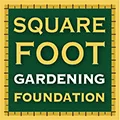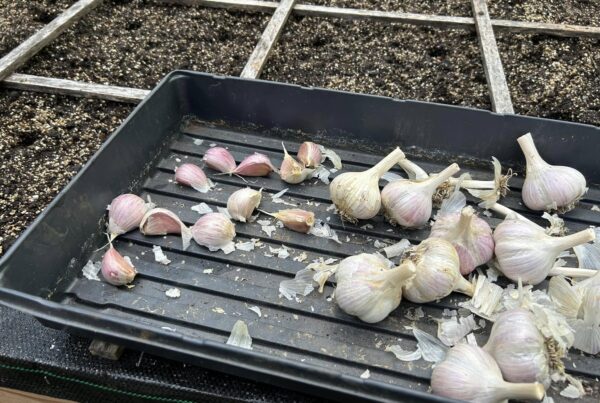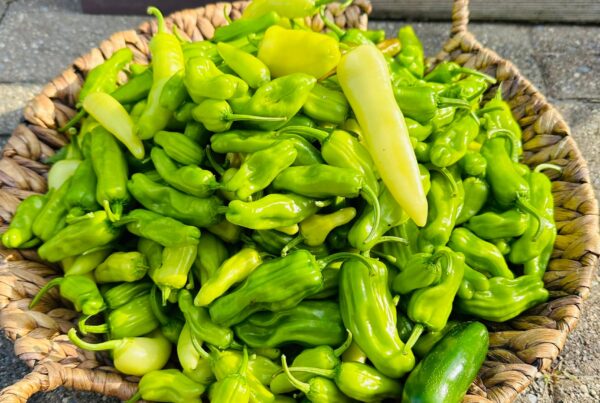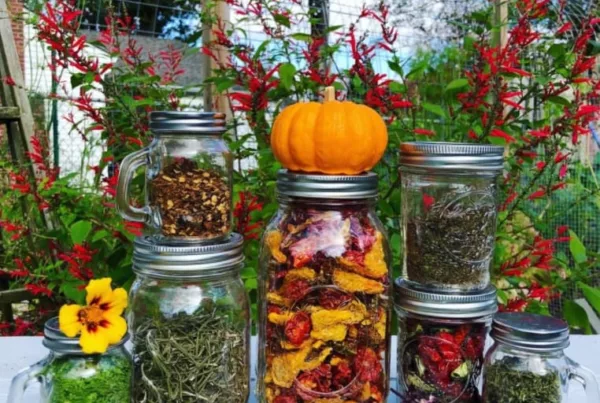Written by Kristina Hicks-Hamblin
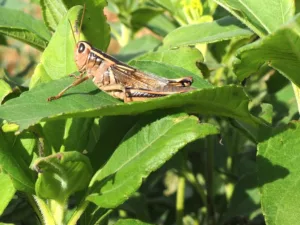 Life is rolling along pretty sweetly in your Square Foot Garden beds until suddenly – your kale is stripped down to the stems, or the lush leaves on your basil have been reduced to nubs. This sad sight may be a sign that you need help managing grasshoppers in your raised bed garden!
Life is rolling along pretty sweetly in your Square Foot Garden beds until suddenly – your kale is stripped down to the stems, or the lush leaves on your basil have been reduced to nubs. This sad sight may be a sign that you need help managing grasshoppers in your raised bed garden!
Let’s talk about how to identify damage from these wildly hopping pests – as well as how to prevent them from becoming problematic in the first place.
Identifying Grasshopper Damage in the Garden
If you live in an area where these pests can be present in extreme numbers (such as the Midwest or certain parts of the Western US), you may know these pests have paid your garden a visit when you find vegetables, herbs, and even flowers nibbled upon – or even mowed down to barely recognizable remains.
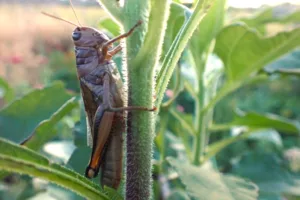
Grasshopper. Photo by Kristina Hicks-Hamblin.
At first there may be scarcely enough damage to know if these insects are indeed the culprits, or if you should lay blame on other garden pests.
If you don’t have a “plague” of these pests, and have only spotted one or two but aren’t noticing much damage, there’s probably no need to panic – just monitor your crops for damage each time you water. These pests tend to leave large, ragged looking holes in plant foliage.
When they are present in large numbers, however, grasshoppers can cause more extensive damage, similar to that caused by mammals such as deer or rabbits.
How to tell the difference between damage inflicted by these hopping insects and hopping or bounding mammals? Unlike their hungry mammal counterparts, these insects often leave behind stems and leaf veins, eating the less fibrous parts of the plant tissue.
Once there are large numbers of these pests around, you’ll have no doubts about who’s moving through your tidy groupings of plants, chewing them to smithereens, as you’ll likely catch glimpses of these insects jumping away from your raised beds as your approach.
By the way, don’t confuse these pests with katydids, an insect that can show up in the garden (usually solo), but which rarely causes much damage. Want to know how to tell the difference? Grasshoppers have short antennas – katydids have long ones.
Which Plants Grasshoppers Target
Some of these hopping insects prefer certain types of vegetation, but when they get desperate – they will gladly eat a flat of marigolds just as happily as a head of lettuce. Large populations can even defoliate newly planted shrubs and trees. However, that doesn’t mean they don’t have preferences.
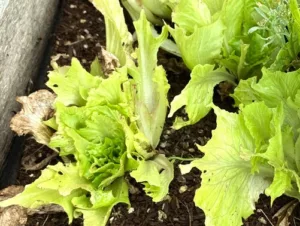
Lettuce destroyed by grasshoppers. Photo by Kristina Hicks-Hamblin.
Think of your garden as your own little nature documentary about predators and prey. In this version however, the grasshoppers are standing in for the lions, and your plants are playing the roles of antelopes at a watering hole. In both cases, weaker individuals are more at risk of being attacked.
So, the first step in growing food (despite the presence of these pests) is to plant as early as you can to get a head start – since established plants are less vulnerable than newly emerging seedlings.
Check out our Planting Chart Cheat Sheet for tips on the best time to plant!
In addition to vulnerable, weaker specimens, some types of crops are more likely to be targeted, and others less so.
According to W.S. Cranshaw and R. Hammon at Colorado State University, peas, squash and tomatoes are not favorites of these pests.
So if you’re planting a succession in an area already infested with these chewing insects, prioritize those plants and avoid the veggies that that they simply can’t resist: beans, carrots, corn, and lettuce.
More Tips for Managing Grasshoppers in the Garden
Once you remember to keep ahead of these pests by planting early, you won’t experience as much crop loss.
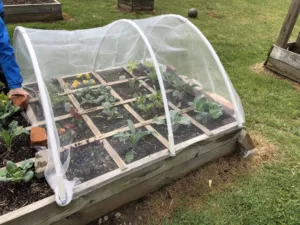
A mesh crop cage helps protect plants from chewing insects like grasshoppers
However, there are some other measures you may want to take as well:
- Keep grass and weeds low around the raised beds. These hopping insects love to hang out in tall vegetation – preventing them from finding refuge in their ideal habitat will help to protect your crops.
- Some gardeners use butterfly nets to catch these hopping pests and then squish them.
- They can also be handpicked when conditions are cool, such as on cloudy days or early in the morning and after sunset, when these insects slow down and are easier to catch.
- Better yet, avoid the dirty work and use crop cages to keep these pests at bay.
Creating a Pest Resilient Garden
In the Square Foot Gardening Method, a polyculture style garden is a must. This strategy helps keep plants healthy, which indirectly helps with pest control – since diseased plants are more vulnerable to predation.
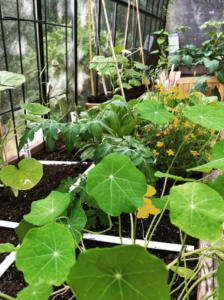
A polyculture garden with flowers and herbs offers food and habitat for beneficials.
Growing a polyculture – a diverse selection of plants – will help you develop a pest resilient garden in another way as well!
By including a diverse selection of plants with different types of flowers in your raised beds, you’ll attract beneficial insects that will help to keep pest populations from exploding.
Insects such as soldier beetles, parasitic wasps, robber flies, tachinid flies, and praying mantises (as well as arachnids like spiders) will feed on grasshopper eggs or larvae.
So don’t be afraid when you find an unknown bug in your raised bed, instead, treat it like a neutral “neighbor” until you confirm that it’s a problem – it may very well be a friend instead of a foe.
Remember, the SFG Method is an organic way to garden, where pesticides are avoided in favor of a more holistic approach.
Cover photo by Kristina Hicks-Hamblin.
